IASbaba's Daily Current Affairs Analysis
Archives
(PRELIMS & MAINS Focus)
Syllabus
- Prelims – Environment and Ecology
Context: In a major setback to rhino conservation in Africa, the proposal to downgrade the status of southern white rhino from Appendix I to Appendix II was accepted at the 19th Conference of Parties (COP19).
- The COP19, organised by Convention on International Trade in Endangered Species (CITES) in Panama City, accepted the proposal by Botswana and Namibia to degrade the status. Wild animal species listed in Appendix I include those threatened with extinction.
About Southern white rhino:

- The southern white rhino and northern white rhino are subspecies of the white rhino. Aside from living in different parts of Africa, they differ slightly in the shape of their teeth and heads, appearance of skin folds, and amount of hair.
- In general, southern whites are a little larger and hairier. Contrary to the species name, both subspecies are Gray in colour.
- “White” may be taken from the Afrikaans word for “wide,” in reference to their mouths, which are wide and square to help them graze on grass.
- COMMON NAME: Southern white rhinoceroses
- SCIENTIFIC NAME: Ceratotherium simum simum
- DIET: Herbivore
- AVERAGE LIFE SPAN IN THE WILD: 39 to 43 years
- AVERAGE LIFE SPAN IN CAPTIVITY: 27 to 30 years
- SIZE: Up to 12 feet
- WEIGHT: Up to 7,900 pounds
Habitat and behavior:
- Nearly 99 percent of southern white rhinos live in the savannas of Kenya, Namibia, and Zimbabwe, though the vast majority are found in South Africa.
- White rhinos are semi-social and territorial. They stay together in herds on the grassy plains and mark their territory with strategically placed deposits of dung.
- The males defend their territory vigorously with their horns and massive sizes.
- Males tend to be more solitary than females, and live on about one square mile of land, whereas females can range over an area almost seven times as large.
- White rhinos love mud. They will roll around in it, cover themselves with it, and cover their young with it. The wet mud cools them and protects their skin from sun and insects.
- Threats: It is mostly threatened by habitat loss, continuous poaching in, and the high illegal demand for rhino horn for commercial purposes and use in traditional Chinese medicine.
- From 2012 to 2017, white rhinos’ population dropped 15 percent, largely because of poaching. Poaching and illegal trade in rhino horn is usually part of sophisticated, organized criminal networks.
Source: DownToEarth
Previous Year Questions
Q.1) With reference to Indian laws about wildlife protection, consider the following statements :
- Wild animals are the sole property of the government.
- When a wild animal is declared protected, such animal is entitled for equal protection whether it is found in protected areas or outside.
- Apprehension of a protected wild animal becoming a danger to human life is sufficient ground for its capture or killing.
Which of the statements given above is/are correct? (2022)
- 1 and 2
- 2 only
- 1 and 3
- 3 only
Q.2) With reference to Indian elephants, consider the following statements:
- The leader of an elephant group is a female
- The maximum gestation period can be 22 months
- An elephant can normally go on calving till the age of 40 years only
- Among the States in India, the highest elephant population is in Kerala
Which of the statements given above is/are correct? (2020)
- 1 and 2 only
- 2 and 4 only
- 3 only
- 1, 3 and 4 only
Syllabus
- Prelims – International Relations
Context: India wins the International Electrotechnical Commission (IEC) Vice Presidency and Strategic Management Board (SMB) Chair for the 2023-25 term.
- By securing over 90% of the votes cast by full members of IEC during its General Meeting held recently in San Francisco, USA, India’s representative, a member of the Indian National Committee of the International Electrotechnical Commission (IEC) and various technical committees of Bureau of Indian Standards (BIS-India), was elected.
About IEC:
- The IEC is a global, not-for-profit membership organization that brings together more than 170 countries including India and coordinates the work of 20 000 experts globally.
- The IEC was founded on 26-27 June 1906 in London, UK. Ever since it has made electrical and electronic technologies safer, more efficient and reliable.
- Standardization Management Board (SMB) is an apex governance body of IEC responsible for technical policy matters.
- The General Assembly is the supreme governing body of the Commission. The General Assembly delegates the management of and oversight over all the Commission’s work to the IEC Board.
- The IEC Board is the core executive body of the Commission and reports to the General Assembly. The IEC Board consists of Officers (without vote) and 15 individual members. It is chaired by the IEC President.
- Individuals on the IEC Board have a fiduciary responsibility to the Commission and its Members.
- The General Assembly consists of the Full Member National Committees of the Commission.
- All electrotechnologies are covered by IEC Standards, including:
- energy production and distribution,
- electronics,
- magnetics and electromagnetics,
- electroacoustics,
- multimedia,
- telecommunication and medical technology,
- terminology and symbols,
- electromagnetic compatibility,
- measurement and performance,
- dependability,
- design and development,
- safety and the environment.
- Vimal Mahendru will be the IEC Vice President representing India.
Source: PIB
Syllabus
- Prelims – Science and Technology
In news: ISRO successfully placed nine satellites, including an Earth Observation Satellite (EOS-06) in multiple orbits with the help of the space agency’s Polar Satellite Launch Vehicle (PSLV-C54).
- The mission was accomplished from Satish Dhawan Space Centre SHAR.
- This is the 56th flight of the Polar Satellite Launch Vehicle (PSLV) and the 24th flight of the PSLV-XL version with 6 PSOM-Xls.
- The nano satellites include ISRO Nano Satellite-2 for Bhutan (INS-2B), Anand, Astrocast (four satellites), and two Thybolt satellites.
About the satellites:
- EOS-6:
- It is the Oceansat series’ third-generation satellite, which provides continued services of Oceansat-2 with enhanced payload capability.
- The satellite onboard carries four payloads.
- It is envisaged to observe ocean colour data, sea surface temperature and wind vector data to use in oceanography, climatic and meteorological applications.
- The satellite also supports value added products such as potential fishing zone using chlorophyll, SST and wind speed, and land based geophysical parameter.

- Astrocast, a 3U spacecraft with 4 Satellites is from Spaceflight Inc, U.S.

- Thybolt is a 0.5U spacecraft bus that includes a communication payload to enable rapid technology demonstration and constellation development for multiple users from Dhruva Space using their own Orbital Deployer with a minimum lifetime of one year.

- The Anand is a three-axis stabilised nano satellite and a technology demonstrator for miniaturised electro-optical payload.

- INS-2B satellite or India-Bhutan satellite has two payloads namely NanoMx, a multispectral optical imaging payload developed by Space Applications Centre (SAC) and APRS-Digipeater, which is jointly developed by DITT-Bhutan and URSC.
- Sub-systems like TTC, power, onboard computer and ADCS from Pixxel, India was also placed in the orbit.
Future launches:
- Aditya-L1, a coronagraphy spacecraft to study the solar atmosphere, with a PSLV rocket.
About Polar Satellite Launch Vehicle(PSLV):
- PSLV is known as the ‘workhorse’ of ISRO.
- It is the third generation launch vehicle of India.
- It is a four-staged launch vehicle with first and third stages using solid rocket motors and second and fourth stages using liquid rocket engines.
- It is the first Indian launch vehicle to be equipped with liquid stages.
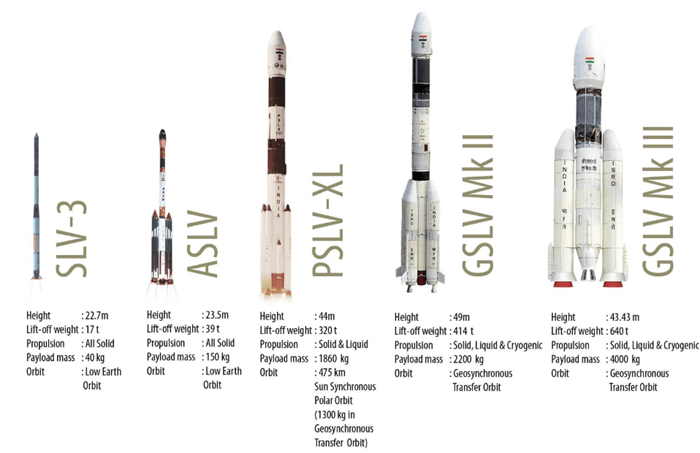
Source: The Hindu
Previous Year Question
Q.1) With reference to India’s satellite launch vehicles, consider the following statements: (2018)
- PSLVs launch the satellites useful for Earth resources monitoring whereas GSLVs are designed mainly to launch communication satellites.
- Satellites launched by PSLV appear to remain permanently fixed in the same position in the sky, as viewed from a particular location on Earth.
- GSLV Mk III is a four-staged launch vehicle with the first and third stages using solid rocket motors; and the second and fourth stages using liquid rocket engines.
Which of the statements given above is/are correct?
- 1 only
- 2 and 3
- 1 and 2
- 3 only
Syllabus
- Prelims – Environment
In news: A reptile endemic to India, the Jeypore Ground Gecko (Cyrtodactylus jeyporensis), has been included in Appendix II of the Convention on International Trade in Endangered Species (CITES).
- The proposal to include the gecko was made by India at the COP19 to CITES in Panama City.
Jeypore Ground Gecko:
- Cyrtodactylus jeyporensis, is a reptile endemic to India.
- IUCN status: Endangered
- The species is rare and was first described by British officer and amateur naturalist Colonel Richard Henry Beddome in 1878 and rediscovered by a team of researchers led by Ishan Agarwal in 2010 and 2011, after a gap of over 130 years.
- The wild reptile species is found in the Eastern Ghats and is known to be present in four locations including southern Odisha and northern Andhra Pradesh.
- Its occurrence is estimated in less than 5,000 square kilometres of fragmented geographical area.
- The species resides below rock boulders in high forested hills at an altitude of 1,100-1,400 metres.
- Threat: pet trade(both in and outside India), degradation, forest fires, tourism, quarrying and mining activity.
- The species does not occur in the protected areas described under the Wild Life (Protection) Act, 1972, thereby making it highly vulnerable to habitat loss and poaching for domestic and international trade.
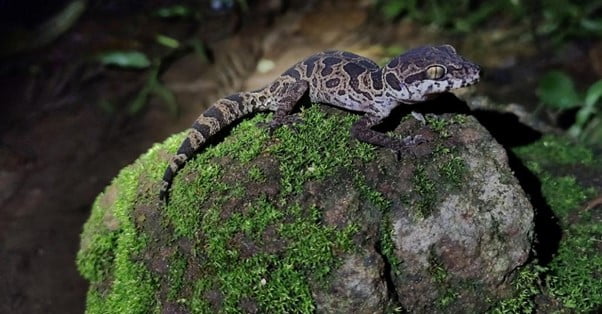
About CITES:
- CITES or Convention on International Trade in Endangered Species of Wild Fauna and Flora or Washington Convention, is a multilateral body to protect endangered plants and animals from the threats of international trade.
- Established in IUCN convention in 1963
- Appendix I: which lists species threatened with extinction
- Appendix II: The animals listed under here may not necessarily be threatened with extinction, but trade in such species should be controlled to ensure it does not threaten their existence.
- Appendix III: species are those that are protected in at least one country, and that country has asked other CITES Parties for assistance in controlling the trade and require a CITES export permit for trade.
Source: Down To Earth
Previous Year Question
Q.1) In which of the following regions of India are you most likely to come across the ‘Great Indian Hornbill’ in its natural habitat? (2016)
- Sand deserts of northwest India
- Higher Himalayas of Jammu and Kashmir
- Salt marshes of western Gujarat
- Western Ghats
Syllabus
- Prelims – Economy
In News: Gautam Adani-led Adani Group, a conglomerate with diverse business interests, acquired 29.18 per cent stake in television channel NDTV Ltd, and said it would launch an open offer as required by the Securities and Exchange Board of India (SEBI) to buy another 26 per cent in the company.
- The single-largest shareholder of NDTV, besides promoters Prannoy Roy and Radhika Roy (32.26%) and the Adani Group (29.18%), is Mauritius-registered foreign portfolio investor (FPI) LTS Investment Fund Ltd with a 9.75% stake.
About open offer:
- According to SEBI (Substantial Acquisition of Shares and Takeovers) Rules, an open offer is an offer made by the acquirer to the shareholders of the target company inviting them to tender their shares in the target company at a particular price.
- The primary purpose of an open offer is to provide an exit option to the shareholders of the target company on account of the change in control or substantial acquisition of shares, occurring in the target company.
- An open offer is triggered if an acquirer holds more than 25 per cent of the public shareholding in the company.
- The open offer price can be lower than the market price as per SEBI Rules.
- Open offer price for acquisition of shares under the minimum open offer shall be 1) the highest negotiated price under the share purchase agreement triggering the offer; 2) the volume-weighted average price of shares acquired by the acquirer during 52-weeks preceding the public announcement; 3) the highest price paid for any acquisition by the acquirer during 26 weeks immediately preceding the PA; and 4) the volume weighted average market price for sixty trading days preceding the PA.
- Significance: After the open offer, If the Adanis manage to get the required 26 per cent stake, the group’s total stake will go up to 55.18 per cent, enabling it to take management control of the target company (NDTV). The acquirer will be able to bring in their own key management persons.
- If the Adanis fail to get a 50 per cent stake, they have the option to buy shares from other institutional investors. The Adanis may have to raise the offer price to get the required majority.
- The Roys have the option to launch a counter offer to the open offer made by the Adanis at a higher price.
Source: Indian Express
Syllabus
- Prelims – Science and Technology
In News: Scientists from the University of Edinburgh and the US Department of Health and Human Services have found that armadillo livers grew substantially when infected with Mycobacterium leprae.
- The pathogen was able to maintain liver function and keep its exquisite architecture intact, giving rise to something that looked like stem cells.
About Leprosy:
- Caused by an acid-fast, rod-shaped bacteria Mycobacterium leprae
- It is a chronic infectious disease that mainly affects the skin, the peripheral nerves, mucosa of the upper respiratory tract, and the eyes.
- Leprosy is curable and treatment in the early stages can prevent disability.
- Treatment includes MDT regimen consists of medicines: dapsone, rifampicin and clofazimine.
About the discovery:
- The leprosy bacteria need functional cells to function within it because of its dependency on the host to survive and replicate.
- It can reprogramme adult Schwann cells, the bacteria’s preferred host niche in the peripheral nervous system to a stage of progenitor/stem-like cells.
- The bacteria’s functions do not involve tumour formation or any adverse effects like fibrosis, it appears safe for now.
- Significance: This discovery may be lifesaving for the two million annual deaths due to liver disease for which there is no licensed therapy.
- Many predicted several new avenues and implications in infection and regenerative medicine
- If we could harness the bacterial ingenuity, the way they hijack the high regenerative capacity of the adult liver, not the use of bacteria as a whole and apply that knowledge to develop strategies to promote organ level growth, keeping architecture of the organ intact for proper function, then certainly such strategies would revolutionise the field of regenerative medicine
- The bacteria were performing something akin to ‘biological alchemy’ — a bacterial pathogen was changing the biology of infected cells to become more ‘valuable’ such that it can promote the growth of a vital organ like the liver in living animals.
About Armadillos:
- They are New World placental mammals in the order Cingulata.
- The Chlamyphoridae and Dasypodidae are the only surviving families in the order, which is part of the superorder Xenarthra, along with the anteaters and sloths.
- All species are native to the Americas, where they inhabit a variety of different environments.
- Armadillos are characterized by a leathery armour shell and long, sharp claws for digging. They have short legs, but can move quite quickly. The average length of an armadillo is about 75 cm (30 in), including its tail.
- When threatened by a predator, Tolypeutes species frequently roll up into a ball; they are the only species of armadillo capable of this.

Source Down To Earth
Previous Year Question
Q.1) Consider the following statements: (2017)
- In tropical regions, Zika virus disease is transmitted by ‘the same mosquito that transmits dengue.
- Sexual transmission of Zika virus disease is possible
Which of the statements given above is/are correct?
- 1 only
- 2 only
- Both 1 and 2
- Neither 1 nor 2
Syllabus
- Mains – GS 2 (Governance)
Context: The Central government has constituted a committee to review the implementation of the Mahatma Gandhi National Rural Employment Guarantee Act (MGNREGA) scheme, especially to assess the programme’s efficacy as a poverty alleviation tool. The committee, headed by former Rural Development secretary Amarjeet Sinha.
About MGNREGA:
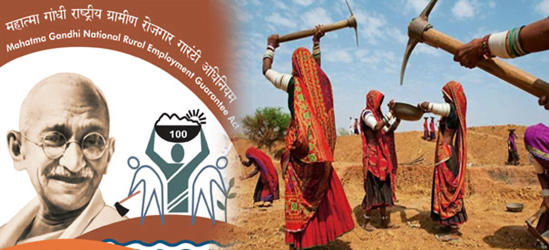
- It is a poverty alleviation programme of the Government of India, which provides the legal Right to Work in exchange for money to the citizens of the country.
- On average, every day approximately 1.5 crore people work under it at almost 14 lakh sites.
- It aims to enhance livelihood security in rural areas by providing at least 100 days of guaranteed wage employment in a financial year to every household whose adult members volunteer to do unskilled manual work.
- Funding: It is shared between the Centre and the States.
- The Central Government bears 100 per cent of the cost of unskilled labour, 75 percent of the cost of semi-skilled and skilled labour, 75 percent of the cost of materials and 6 percent of the administrative costs.
- Current employment: There are currently 15.51 crore active workers enrolled under the scheme.
Features of MGNREGA scheme:
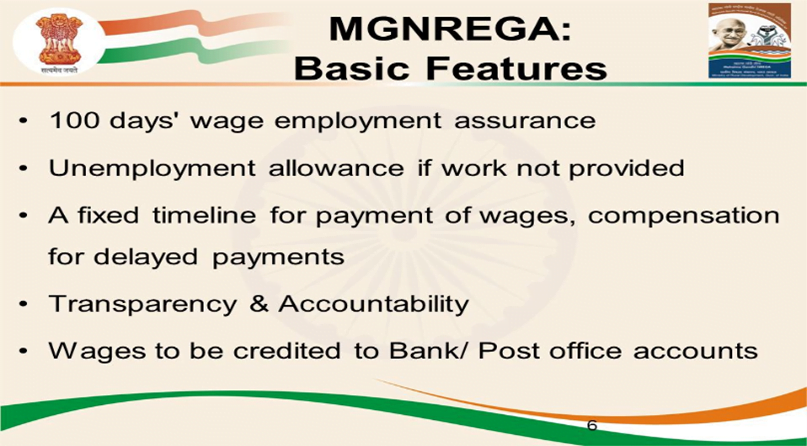
- Legal Right to Work:
- The Act provides a legal right to employment for adult members of rural households.
- Women labour force:
- At least one-third of beneficiaries have to be women. Wages must be paid according to the wages specified for agricultural labourers in the state under the Minimum Wages Act, 1948.
- Time-Bound Guarantee of Work:
- Employment must be provided within 15 days of being demanded to fail which an ‘unemployment allowance’ must be given.
- Decentralised Planning:
- Panchayati Raj Institutions (PRIs) are primarily responsible for planning, implementation and monitoring of the works that are undertaken.
- Gram Sabha’s must recommend the works that are to be undertaken and at least 50 per cent of the works must be executed by them.
- Transparency and Accountability:
- There are provisions for proactive disclosure through wall writings, Citizen Information Boards, Management Information Systems and social audits (conducted by Gram Sabha’s).
Significance of the scheme:
- It is a social security scheme to generate employment for the rural poor and ensure livelihood for people in rural areas.
- The scheme sees large-scale participation of women, Scheduled Castes (SCs) and Scheduled Tribes (STs) and other traditionally marginalised sections of society.
- It increases the wage rate in rural areas and strengthens the rural economy through the creation of infrastructure assets.
- It facilitates sustainable development which is very clear by its contribution in the direction of water conservation.
- The program provided a sigh of relief to millions of migrants and other people who lost their livelihood in the pandemic times. The scheme ensured that the vulnerable get access to basic income thereby decreasing suicide rates in the country.
- The scheme has led to the creation of common community assets. These assets are built by communities on common lands thereby creating a sense of responsibility towards the structure which results in better care.
- For instance, many Johads (percolation ponds) and check dams had remained abandoned for several years in many villages of Karnataka. However, villagers revived them under the MGNREGA.
Performance of MGNREGA during Covid-19 Pandemic:
- According to the government data, over 11 crore people worked under MGNREGS during the financial year 2020-21 alone. Few other achievements of the Scheme last year are,
- This is the first time since the launch of the scheme in 2006-07 that the MGNREGS numbers crossed the 11-crore mark in a year.
- Further, the 11 crore mark is also higher by about 41.75% if we compare 2019-20 data (about 7.88 crores worked).
- In 2020-21, the total expenditure was 62.31% higher than in 2019-20.
- As part of the economic package during the Covid-19 pandemic, the government announced additional funding of Rs 40,000 crore for the MGNREGS over and above the budgetary allocation of 2020-21.
Issues with MGNREGA:
- Poor maintenance: Many structures created under MGNREGA become defunct due to poor maintenance. This simply implies the wastage of time, energy, and resources.
- Data on the impact of productive assets: The government does not monitor whether a structure has actually helped water conservation. Further, there is no government data on the impact on groundwater levels, improvements in livelihoods etc. post the creation of assets.
- Inadequate Funds: A huge surge in demand for MGNREGA works has been witnessed in pandemic times. But the government hasn’t duly allocated funding in a similar proportion.
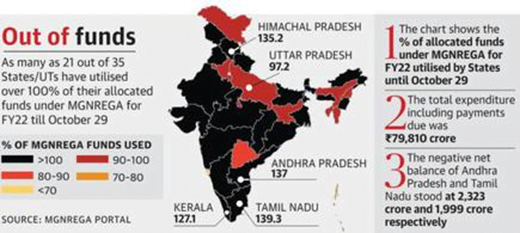
- Insufficient support: With the unemployment rate reaching a 45-year high at 6%, giving merely 100 days of employment is not sufficient.
- Payment Delays: Despite Supreme Court orders, various other initiatives and various government orders, no provisions have yet been worked out for calculation of full wage delays and payment of compensation for the same.
- Corruption and Irregularities: Funds that reach the beneficiaries are very little compared to the actual funds allocated for the welfare schemes.
- Discrimination: Frequent cases of discrimination against women and people from the backwards groups are reported from several regions of the country and a vast number goes unreported.
- Non-payment of Unemployment Allowance: There is a huge pendency in the number of unemployment allowances being shown in the Management Information System (MIS).
Suggestion measures:
- There is a need to carry out social audits as per rules and effective implementation of the delay compensation system.
- The participation of women and backwards classes must be increased by raising awareness and making it more inclusive.
- The people should be sensitised to do away with the discrimination against them.
- Reasons for poor utilisation of funds should be analysed and steps must be taken to improve them.
- In addition, actions should be initiated against officers found guilty of misappropriating funds.
- Villages must also be allowed to take control of their own water security, noting that catchment areas for many villages are on land controlled and owned by the Forest Department.
- The government should provide greater funds for the proper implementation of the scheme. It currently provides 0.47% of GDP while the World Bank recommends 1.7 % for the optimal functioning of the program.
- The frequency of monitoring by National Level Monitors (NLMs) should be increased and appropriate measures should be taken by States based on their recommendations.
The National Rural Employment Guarantee Act (MGNREGA) 2005 is a milestone in India’s history of post-independence social security laws. Made after a successful legal struggle to secure employment, it is a partial victory for the full right of employment in any developing country. An important aspect of this law that distinguishes it from any other public service delivery system is its defeat by the Indian parliament.
Thus, the MNREGA programme has definitely brought about development in rural households, allowing them to access many facilities and improve the quality of their lives.
Source: The Hindu
Syllabus
- Mains – GS 2 (International Relations)
Context: Recently, the Australian parliament ratified the India-Australia free trade agreement, the Economic Cooperation and Trade Agreement (ECTA).
About Free Trade Agreement (FTA):
- A free trade agreement is an agreement in which two or more countries agree to provide preferential trade terms, tariff concession etc. to the partner country.
- India has negotiated FTA with many countries and trade blocs e.g., Sri Lanka, Singapore, ASEAN etc.
About India- Australia ECTA:
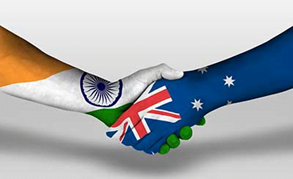
- The Agreement encompasses cooperation across the entire gamut of bilateral economic and commercial relations between the two countries and covers areas such as:
- Trade in Goods and services, Rules of Origin
- Technical Barriers to Trade (TBT), sanitary and Phytosanitary (SPS) measures.
- Dispute Settlement, Movement of Natural Persons.
- Telecom, Customs Procedures, Pharmaceutical products, and Cooperation in other Areas.
- ECTA provides for an institutional mechanism to encourage and improve trade between the two countries and covers almost all the tariff lines.
- Zero duty benefits on 98.3% of Australian tariff lines, from the day the agreement comes into force, will be extended to all Indian products within five years.
- Australia, in turn, will get zero duty benefits for 90% of its exports (in value terms) to India.
- Under the agreement, Indian graduates from STEM (Science, Technology, Engineering and Mathematics) will be granted extended post-study work visas.
- Australia will also set up a programme to grant visas to young Indians looking to pursue working holidays in Australia.
- Annual Visa quota of 1800 is to be instituted for India Yoga teachers and Chefs.
Evolution of India- Australia relations over time:
India-Australia bilateral trade at a glance:
- Australia is the 17th largest trading partner to India and India is Australia’s 9th largest trading partner.
- In 2021-22, India’s goods exports to Australia valued US$8.3 billion and imports were about US$16.7 billion.
- Two-way trade in goods and services in 2020 was valued at US$24.3 billion.
- India’s merchandise exports to Australia grew 135 percent between 2019 and 2021.
- India’s exports consist primarily of a broad-based basket largely of finished products.
- Around 96 percent of Australia’s exports are raw materials and intermediate products.
Bipartisan support in the backdrop China factor:
- India-Australia partnership enjoys wide, bipartisan support in Australia because Australia has been particularly upset with what it called the ‘weaponization of trade’ by China.
- It has surely helped galvanize sentiment about India being a more trustworthy partner.
Shared interests and new partnerships:
- The two countries are already part of recently formed global cliques such as the four-nation Quad, the trilateral Supply Chain Resilience Initiative and the Indo-Pacific Economic Forum (IPEF).
- Both the countries are facing an assertive China challenge which brings the two countries together for converged interests.
Strong ties and democracy:
- Both the countries have been part of the Commonwealths and are among the prominent democracies which make them likable partners.
New opportunities:
- The bilateral trade deal is a strong positive signal about India’s credentials to a world shuffling its feet away from dodgy supply chains towards a ‘China plus one’ strategy.
Impact of the Economic Cooperation and Trade Agreement (ECTA):
- India expects bilateral trade to rise to about $50 billion from the current level of $31 billion in five years, with Indian exports driving half this surge.
- India hopes to increase its merchandise exports by US$10 billion by 2026-27.
- The ECTA will create a million new jobs in labour-intensive sectors Gems and Jewellery, Textiles, leather, footwear, furniture etc.
- Raw materials such as coal, metals and wool dominate Australia’s export shipments meaning cheaper inputs for Indian firms.
- The approval of a double taxation avoidance agreement by Australia, which is expected to save millions of dollars a year for Indian IT firms.
Way Forward:
- The new age free trade agreements are based on reciprocal economic benefits and enhanced trade facilitation ,India can resort to ways which will facilitate smoother trade
- India needs to improve the efficiency of ports, shipping, Customs, etc., via automation which would be a big boost for participation by MSMEs.
- Developing alternative sources of supply in which all the components are available in vicinity and locally.
- India must look at a hybrid model to source from the most efficient suppliers, including domestic players.
- The new-age FTAs demand more holistic and diversified trade opportunities with trade in services, e-commerce, labour, climate/environment, digital trade, public procurement, supply chains etc.
Although, the India-Australia ECTA will further cement the already deep, close and strategic relations between the two countries and will significantly enhance bilateral trade. It is critical to remember that trade deals open new doors, but do not automatically mean higher exports or better trade balances, as India’s past pacts with ASEAN and Japan have shown.
There is no shortcut or alternative to fixing India’s overall global competitiveness and the policy makers and other stakeholders need to take a leap forward to improve India’s competitiveness to secure India’s interests.
MUST READ: India – Australia Relations
Source: The Hindu
Syllabus
- Mains – GS 4 Ethics
Context:
- Artificial Intelligence (AI) is being deployed in ways that touch people’s lives, including in areas of healthcare, financial transactions, and delivery of justice.
- Advances in AI can have profound impacts across varied societal domains, and in recent years, this realisation has sparked ample debate about the values that should guide its development and use.
- Hence, there is a need to resolve differences in interpretation or attribution and document a better articulated AI landscape.
Five ethical principles of AI:
- Transparency: transparent processes in the development and design of AI algorithms, to increase interpretability, explain ability, or other acts of disclosure.
- Justice and fairness: AI may increase inequality and reinforce societal biases if they are not addressed adequately.
- Responsibility and accountability: This include clarifying legal liability, focusing on underlying processes that may cause potential harm, or whistleblowing in case of potential harm.
- Privacy: Both as a value to uphold and as a right to be protected in ethical AI, in relation to data protection and data security
- Non-maleficence: It indicates the precedence of moral obligation to preventing harm over the promotion of good.
- This could be due to a negativity bias in characterisation of ethical values concentrating more on negative issues and events rather than positive ones.
- It means encompassing calls for safety and security and includes beneficence.
Challenges in principles:
- Interpretation and conflict: How the same principles are interpreted across various guideline documents. For instance, the need for more datasets to “unbias” AI conflicts with individuals’ data security and privacy.
- Attribution: interpreting which domain, actor, or issue these ethical principles pertain to.
- Such divergences could undermine attempts to develop a global ethical AI agenda because varied perspectives, for example risk-benefit evaluations, will lead to different results based on whose well-being they are developed for or the actors involved in developing them.
- For instance, does the European guideline on privacy also apply to China where privacy guidelines target only private companies, and citizens are accustomed to living in a protected society with high trust in their government?
- Implementation: Whether through government organisations, inter-governmental organisations, industry leaders, individual users or developers, or by harmonising AI agendas across the board.
- If harmonisation is a goal, then how does one account for moral pluralism and cultural diversity across countries.
- Environmental Ethics and Sustainability: AI deployment requires massive computational resources, and thus high energy consumption and calls into question the possibility of harnessing the benefits of AI for the entire biosphere.
- Integrity: means being explicit about best practices and disclosure of errors.
- Solidarity and Equity: in solving socio-economic challenges like job losses, inequality, and unfair sharing of burdens. For instance, compensating humans whose actions provide data for training AI models.
Suggestions for future:
- Defining Principles: Admittedly, principles are difficult to translate into practice. However, they still play a crucial role in building awareness and acting as catalysts for building beneficence and a culture of responsibility among AI developers.
- Internalised norms and values and an effective AI governance strategy will require both—principles encouraging cultural change in the AI community, and explicit rules and regulations buttressing them.
- A unified regulatory and policy framework on the ethical, economic, and social implications of advances in AI that established clear fiduciary duties towards users.
- A homogeneous professional standards and moral obligations of what it means to be a “good” AI developer.
- Strong institutions that ensure ethical conduct on a daily basis.
- Ad-hoc committees like United States National Artificial Intelligence Advisory Committee (NAIAC) that dispenses advice to the president and various federal officials; the expert group on AI at the Organisation for Economic Co-operation and Development (OECD); the High-Level Expert Group on AI formed by the European Commission; and the Select Committee on AI appointed by the UK Parliament’s House of Lords.
- Professional and legal accountability mechanisms to redress misbehaviour and ensure that standards are upheld.
- Private sector involvement like Google, IBM, Intel, Microsoft, and Sony, have released guidelines for developing ethical AI.
- Civil society including Non-profit organisations and professional associations, such as the Institute of Electrical and Electronics Engineers (IEEE), Internet Society, Open AI, and the World Economic Forum have also issued declarations and recommendations on AI principles and policies.
Way forward:
- It is time to move towards a principles-led approach to AI and define clear long-term pathways, set explicit professional standards, and build accountability structures that are not only country-specific but also sector- and organisation-specific.
- Mechanisms should also be set up to license developers of applications with elevated risks, such as facial recognition tools or other systems trained on biometric data.
- Privacy-preserving techniques, like homomorphic encryption or federated learning, have been developed for the use of data and learning algorithms.
Source: Orf Online
Practice MCQs
Q.1) With reference to India’s satellites, consider the following statements:
- EOS-6 is an Ocean sat series’ satellite that carries two payloads.
- The Anand is a nano satellite for miniaturised electro-optical payload.
Which of the statements given above is/are correct?
- 1 only
- 2 only
- Both 1 and 2
- Neither 1 nor 2
Q.2) In which of the following regions of India are you most likely to come across the ‘Jeypore Ground Gecko’ in its natural habitat?
- Himalayan Mountains
- Salt marshes of West Bengal
- Western Ghats
- Eastern Ghats
Q.3) Consider the following statements regarding International Electrotechnical Commission (IEC):
- The IEC is a global, not-for-profit membership organization that brings together more than 170 countries.
- India is not a member of IEC.
- Recently Vimal Mahendru elected as the IEC Vice President representing India.
Which of the statements given above are correct?
- 1 and 2 only
- 2 and 3 only
- 1 and 3 only
- 1 2 and 3
Comment the answers to the above questions in the comment section below!!
ANSWERS FOR ’28th November 2022 – Daily Practice MCQs’ will be updated along with tomorrow’s Daily Current Affairs.st
ANSWERS FOR 26th November – Daily Practice MCQs
Q.1) – c
Q.2) – b
Q.3) – d














